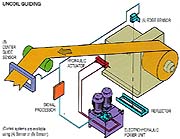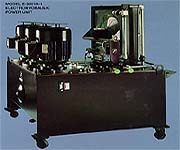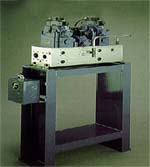 |

|
 Fife uncoiler systems allow the strip to be continuously
payed off to a predetermined point, utilizing either edge
guide or center guide sensors. The wide-gap reflex
edge sensor (A) shown here is designed to be located
adjacent to the uncoiler, providing stable, accurate
edge guiding results. An alternate solution to uncoil
guiding might be the installation of a narrow-gap,
wide-band, center guide sensor (B) downstream of the
pinch roll/flattener and a control algorithm which
compensates for the phase lag in such a system.
Fife uncoiler systems allow the strip to be continuously
payed off to a predetermined point, utilizing either edge
guide or center guide sensors. The wide-gap reflex
edge sensor (A) shown here is designed to be located
adjacent to the uncoiler, providing stable, accurate
edge guiding results. An alternate solution to uncoil
guiding might be the installation of a narrow-gap,
wide-band, center guide sensor (B) downstream of the
pinch roll/flattener and a control algorithm which
compensates for the phase lag in such a system.
|
 |
 Features designed into Fife heavy-duty
electrohydraulic power units resulted from an
extensive "needs" study conducted among steel mill
engineers responsible for specifying and maintaining
strip guiding equipment. As a result, these power units
are rugged, reliable, and responsive, providing
simplicity of design, operation, and maintenance. They
employ modular motor-pump assemblies for ease and
speed of maintenance, pump replacement, etc. With
optional standby power, they can operate with one
motor -pump module running while the other is being
serviced. Internal check valves automatically isolate
the active and inactive modules.
Features designed into Fife heavy-duty
electrohydraulic power units resulted from an
extensive "needs" study conducted among steel mill
engineers responsible for specifying and maintaining
strip guiding equipment. As a result, these power units
are rugged, reliable, and responsive, providing
simplicity of design, operation, and maintenance. They
employ modular motor-pump assemblies for ease and
speed of maintenance, pump replacement, etc. With
optional standby power, they can operate with one
motor -pump module running while the other is being
serviced. Internal check valves automatically isolate
the active and inactive modules.
|
 |
1. Vertically mounted pumping module eliminates pump-coupling-motor
alignment problems. Complete power module is easily removed with portable
hoist. An optional standby module functions independently to assure continuous
operation during parts replacement or routine maintenance.
2. Submerged hydraulic pump increases life, reduces noise level, and eliminates internal damage from cavitation encountered with exposed pumps.
3. Pressure-compensated, variable volume, piston-type hydraulic pump
runs "unloaded"
except on demand, greatly reducing power consumption, and
providing maximum pump life.
4. Proportional electronically actuated, two-stage, spool-type servo
valve provides optimum accuracy, reliability, and efficiency, Can be furnished
with multiple servo valves for alternate control of multiple coilers.
5. Submerged piping and subplate porting eliminate most external piping
6. Compatible with phosphate ester fluid and other fire-resistant fluids
7. Auxiliary hydraulic ports for optional double-stub traversing or sensor positioning
circuits
|

- For gaps up to 10 feet (3m)
- ldeal for highly reflective strips
- Pulsed LED unaffected by ambient light
- Fully proportional
- Regulated lamp voltage power supply for improved accuracy
- Rugged dust-tight and oil-tight enclosure
- Compatible with "seek" and "stagger wind" features
- Simple to set up
- Rugged positioner optional-sensor manually or hydraulically positioned
- Optional strip width indicator
- SE-20 Sensor may also be used for recoiler guiding
|

|
 This package is an integrated hydraulic circuit consisting of
subplate-mounted, electrically operated valves.
The solenoids are prewired to a terminal box, and the
hydraulic connection can be made easily at the side of the
manifold block.
This system is used where it is desirable to operate two
stubs or cone mandrels simultaneously or independently.
It may be used with or without a guiding circuit.
In seeking dynamic equilibrium, a strip will tend to track
perpendicularly to an oncoming roll and is subject to factors
of rigidity, stress distribution, inertia, friction, and load
distribution. These and other factors cause uneven stress and "offtracking" that create
expensive problems. The solution is the proper selection and application of Fife
intermediate guiding systems. Control systems are available for both edge guiding and
center guiding requirements. Most intermediate guides are furnished with a center guide
sensor-making adjustments for strip width changes unnecessary and eliminating the need
for operator attention.
This package is an integrated hydraulic circuit consisting of
subplate-mounted, electrically operated valves.
The solenoids are prewired to a terminal box, and the
hydraulic connection can be made easily at the side of the
manifold block.
This system is used where it is desirable to operate two
stubs or cone mandrels simultaneously or independently.
It may be used with or without a guiding circuit.
In seeking dynamic equilibrium, a strip will tend to track
perpendicularly to an oncoming roll and is subject to factors
of rigidity, stress distribution, inertia, friction, and load
distribution. These and other factors cause uneven stress and "offtracking" that create
expensive problems. The solution is the proper selection and application of Fife
intermediate guiding systems. Control systems are available for both edge guiding and
center guiding requirements. Most intermediate guides are furnished with a center guide
sensor-making adjustments for strip width changes unnecessary and eliminating the need
for operator attention. |






